rule-110-in-bitcoin-script
Rule 110 in Bitcoin Script
Video explanation
On the (testnet) blockchain
The following transaction spent coins from an address where the act of checking that the spend was valid required all bitcoin nodes to execute two generations of a Rule 110 Cellular Automaton after being given the first generation as input: https://blockstream.info/testnet/tx/3dbdc2142f5e006a0bcd186abbb85a5f6612c8c25666ee039776ce3e970df1c7?expand
Here is the raw transaction hex: 020000000001015ebd88469de17bce4e9da9d330562f4a6792a2a13caa8a5018bb3f0038cb68e40000000000feffffff01bc02000000000000160014ff9da567e62f30ea8654fa1d5fbd47bef8e3be13050000000101e1006f7c639a916b51676b686d74518763007c6874528763007b7b686f7c639a916b51676b686d74518763007c6874528763007b7b686f7c639a916b51676b686d74518763007c6874528763007b7b686f7c639a916b51676b686d74518763007c6874528763007b7b686d756c6c6c6c006f7c639a916b51676b686d74518763007c6874528763007b7b686f7c639a916b51676b686d74518763007c6874528763007b7b686f7c639a916b51676b686d74518763007c6874528763007b7b686f7c639a916b51676b686d74518763007c6874528763007b7b686d756c6c6c6c6d6d5100000000
What is Rule 110?
Rule 110 is a name for a group of black and white patterns. A common one appears in this picture:

It is an object of study by computer scientists because if you modify the top line of the image, the pattern it produces changes in predictable ways, and you can use this predictable behavior to write programs that allow people to supply any sequence of black squares and white squares as input and get an output on some lower line of the image. If users supply real information to a Rule 110 program, the Rule 110 program can manipulate that information however the programmer wants it to, and you can always tell the users that they will find the result of the computation on some pre-agreed line lower down in the image. There is more information in the wiki: https://en.wikipedia.org/wiki/Rule_110
What I think is cool is that the rules for creating a Rule 110 machine can be written in Bitcoin Script and executed by bitcoin nodes.
Does this mean bitcoin’s programming language, Bitcoin Script, is turing complete?
I think so, but I am not an expert on these things and I am probably missing something. Last year a guy did a similar thing on the Bitcoin SV network and there was an interesting thread on Hacker News about it. In that thread, someone smarter than me thinks it doesn’t count as turing complete for several reasons. One of them (the lack of loops) is dealt with below, another one is that you have to prepare these addresses with lots of parameters that are usually not known in normal turing machines. For example, I knew that my program would process 4 bits of data so I manually instructed it to halt after processing those four bits. A normal turing machine could process varying numbers of bits, even billions of bits. There would be some code inside the program that checks if there is any more input and that checker function would automatically tell the program to halt when there is none. But my implementation lacks that feature so maybe it’s still not a real turing machine.
On the other hand, I think I could probably implement an input length checker like that very easily, and I don’t think such a checker is really necessary for a machine to count as turing complete. All real-world turing machines have limited resources, such as memory, and therefore they cannot process an unlimited number of bits. If they try to process a program that consumes more resources than they have available, their checker will never fire and the turing machine will just break after it runs out of memory or a source of energy or after its mechanical parts wear out. Bitcoin’s security measures help prevent breakage by severely limiting the number of operations you can do, as well as how much data you can process, but since all real world turing machines have limits too (just much larger ones) I think it’s fair to call my Rule 110 simulator a universal turing machine, even without something that checks the length of the user’s input and automatically tells it to halt when all the data is processed.
What about loops? I thought you needed loops to be turing complete, and bitcoin does not have loops
I don’t think you need them. A turing machine needs to move between different states of operation where it does different things depending on the user’s input, but it’s okay if those states are laid out sequentially. Then the machine just progresses from e.g. state 0 to state 1 to state 2 and those states all tell it what to do depending on what the user’s input is. A machine that operates in this way never needs to “loop back” to a prior state. So you don’t actually need loops to simulate a turing machine – or at least I don’t think you do, but maybe I’m missing something.
I will note that a lot of people who are much smarter than me think loops are basically the defining feature that sets a Turing machine apart from every other type of virtual machine. For example, Russell O’Connor said: “every [Turing-complete] programming language must have infinite loops while Bitcoin Script has no looping behavior at all.” source He also said: “Unbounded search is literally the defining feature that sets apart Turing complete languages from Turing incomplete languages.” source
I don’t agree with him but that probably just means I am wrong. I think loops are simulatable by taking the function you want to loop and, instead of doing a loop, copy-paste that function a billion times in a row, while having each of these billion functions pass its output to the next function as input. Obviously that’s not actually “unbounded” or “infinite,” but I don’t think any Turing machine actually has unbounded or infinite capabilities either, because all of them are made in the real world where resources are not infinite. My set of a billion sequential functions and your unbounded loop language will both compute all functions except the ones that require so much processing, the processor falls apart before it finishes processing the data. Therefore I say loops can be effectively simulated by copy-pasting an identical function many times. But in a contest between me and Russel O’Connor, you should listen to him, not me. So there’s that.
If Rule 110 is turing complete, is it useful to simulate it in Bitcoin Script?
I’m really not sure but quite possibly not. Bitcoin’s limitations on script length include a rule that no more than 200 operations can be performed in a given script (with an exception for operations that only deposit a number onto the stack). A Rule 110 program that actually did anything signficant would probably need to perform hundreds of thousands of operations on the user’s input, and the user’s input would also need to be absolutely massive. So this is really just a toy simulator, not something you can realistically do meaningful processing with. But I don’t need it to be useful. I had a lot of fun making it and to me the fun is worth the effort.
On the other hand, if I’m right that Bitcoin Script is turing complete, there are some very useful things you can do without simulating Rule 110, which is incredibly inefficient as a computing device anyway. The very existence of my “Proof of Turing Completeness” (if my proof is valid, which it might not be) may prompt some people to seek out some of the other unexpected things Bitcoin Script can do. It’s certainly got me on the watch for fantastic discoveries. The cellular automaton I simulated creates an environment on the boundary between chaos and stability. To me that sounds like a pretty neat place to explore.
How does it work?
The heart of the program is this function, which takes any sequence of 3 binary digits as input and computes an output that corresponds to what it should be on a Rule 110 table, which it then outputs to the altstack:
OP_SWAP
OP_IF
OP_BOOLAND
OP_NOT
OP_TOALTSTACK
OP_1
OP_ELSE
OP_TOALTSTACK
OP_ENDIF
I originally implemented a Rule 110 output function that was much larger, it had 55 operations instead of 9. It caused problems because I couldn’t run the function very many times without consuming the 200 operations I am allowed to use according to bitcoin’s consensus rules. But then Dusty Daemon took a look at my code and suggested using boolean logic to compress the function. I googled to see if anyone had a compressed way of computing Rule 110 outputs using boolean logic and I found this research paper: https://peerj.com/preprints/2553.pdf The author proves that Rule 110’s output can be computed using this pseudocode:
If c == true:
print(p NAND q)
Else:
print(q)
End if
Which is what I implemented in Bitcoin Script above. (The extra <1> I outputed in my version is necessary so that the program always leaves 1 element on the stack, which is required by other parts of my overall program.) I am really glad that someone figured out what is probably the most efficient possible way to compute Rule 110 outputs – standing on the shoulders of giants is the only way my program works at all.
A few prefixes and suffixes
To compute a full line of Rule 110 the program can’t just run the Rule 110 output function on 3 digits. It needs to take a string of varying length as input and run many times to compute a full line. To do this my program adds to the main function a few prefixes and suffixes. It also needs room to run a bunch of times – as many times as the inputs you provide. E.g. if the programmer wants users to provide a sequence of 10 0s and 1s as input, he or she will need to copy/paste the Rule 110 output function 10 times. He or she will also need to apply the following prefix before each run of the function: OP_3DUP (My rule 110 function consumes the top 2 digits of input but the bottom 2 need to be used again the next time it runs, so I duplicate all 3 and then drop 2 inputs later after the program runs.)
The program also needs the programmer to apply the following suffix after each run of the function:
OP_2DROP
OP_DEPTH
OP_1
OP_EQUAL
OP_IF
OP_0
OP_SWAP
OP_ENDIF
OP_DEPTH
OP_2
OP_EQUAL
OP_IF
OP_0
OP_ROT
OP_ROT
OP_ENDIF
This sequence of commands cleans up the stack and loads the next set of 3 inputs so that they can be processed by the Rule 110 output function. If we are nearing the end of the stack it also adds up to two 0s to the bottom of the stack so that the OP_3DUP function won’t fail when the stack runs out of elements. This is fine because Rule 110 assumes that if you are computing the output of only 2 digits, there is an imagined third one that is always a 0.
When all of these prefixes and suffixes are applied I get this result which I repeat for however many inputs there are to the program:
OP_3DUP
OP_SWAP
OP_IF
OP_BOOLAND
OP_NOT
OP_TOALTSTACK
OP_1
OP_ELSE
OP_TOALTSTACK
OP_ENDIF
OP_2DROP
OP_DEPTH
OP_1
OP_EQUAL
OP_IF
OP_0
OP_SWAP
OP_ENDIF
OP_DEPTH
OP_2
OP_EQUAL
OP_IF
OP_0
OP_ROT
OP_ROT
OP_ENDIF
You can see that this sequence of opcodes and numbers repeats 4 times in the top half of the witness script that I actually ran on the blockchain:
OP_3DUP OP_SWAP OP_IF OP_BOOLAND OP_NOT OP_TOALTSTACK OP_PUSHNUM_1 OP_ELSE OP_TOALTSTACK OP_ENDIF OP_2DROP OP_DEPTH OP_PUSHNUM_1 OP_EQUAL OP_IF OP_0 OP_SWAP OP_ENDIF OP_DEPTH OP_PUSHNUM_2 OP_EQUAL OP_IF OP_0 OP_ROT OP_ROT OP_ENDIF OP_3DUP OP_SWAP OP_IF OP_BOOLAND OP_NOT OP_TOALTSTACK OP_PUSHNUM_1 OP_ELSE OP_TOALTSTACK OP_ENDIF OP_2DROP OP_DEPTH OP_PUSHNUM_1 OP_EQUAL OP_IF OP_0 OP_SWAP OP_ENDIF OP_DEPTH OP_PUSHNUM_2 OP_EQUAL OP_IF OP_0 OP_ROT OP_ROT OP_ENDIF OP_3DUP OP_SWAP OP_IF OP_BOOLAND OP_NOT OP_TOALTSTACK OP_PUSHNUM_1 OP_ELSE OP_TOALTSTACK OP_ENDIF OP_2DROP OP_DEPTH OP_PUSHNUM_1 OP_EQUAL OP_IF OP_0 OP_SWAP OP_ENDIF OP_DEPTH OP_PUSHNUM_2 OP_EQUAL OP_IF OP_0 OP_ROT OP_ROT OP_ENDIF OP_3DUP OP_SWAP OP_IF OP_BOOLAND OP_NOT OP_TOALTSTACK OP_PUSHNUM_1 OP_ELSE OP_TOALTSTACK OP_ENDIF OP_2DROP OP_DEPTH OP_PUSHNUM_1 OP_EQUAL OP_IF OP_0 OP_SWAP OP_ENDIF OP_DEPTH OP_PUSHNUM_2 OP_EQUAL OP_IF OP_0 OP_ROT OP_ROT OP_ENDIF
A few more prefixes and suffixes
By repeating the Rule 110 output function 4 times, Bitcoin Script can take any line of any 4 digit Rule 110 pattern as input and compute the next line as output. But it’s not ready yet, it needs a few more prefixes and suffixes and there is space to compute 2 lines so let’s do that.
Earlier I said that if you are computing the output of only 2 digits using Rule 110, there is an imagined third digit that is always a 0. That’s not only true when you are nearing the end of the input elements, it’s also true at the beginning. Another way of saying that is this: to compute the “rightmost” digit of each line of the Rule 110 pattern, assume there is a 0 after whatever digits you supplied as input. So my function needs to deposit a zero onto the top of the stack right off the bat, which is why the first instruction in my witness script is OP_0. That prefix needs to be applied before you compute any line of Rule 110 so we will end up putting it on the stack twice, once at the beginning of the witness script and once in the middle.
Also, when you compute the second line of Rule 110 from the first (remember, the first line is supplied as input), the outputs are all deposited to the altstack. To use them as input for the third line of Rule 110, we need to retrieve them from the altstack. But before doing that, we need to “tidy up” the stack, because the suffix to the Rule 110 output function always adds up to two 0s to the stack when we are nearing the end of the stack, and once the line is complete we don’t need those 0s anymore. So let’s tidy up the stack by dropping the last two 0s and then retrieve Line 2 (which is currently on the altstack) as input for Line 3.
OP_2DROP
OP_DROP
OP_FROMALTSTACK
OP_FROMALTSTACK
OP_FROMALTSTACK
OP_FROMALTSTACK
The whole program
If you had 10 bytes of input and if you consequently ran the Rule 110 output function 10 times, you’d need to retrieve 10 items from the altstack, but here I am only retrieving 4 items because I assume there are only 4 bytes of input. But we’re almost done! By retrieving the bytes from the altstack we are back in our starting position except with a new input line, so we can duplicate what we did before to get the third line of Rule 110. The whole program looks like this:
OP_0 OP_3DUP OP_SWAP OP_IF OP_BOOLAND OP_NOT OP_TOALTSTACK OP_PUSHNUM_1 OP_ELSE OP_TOALTSTACK OP_ENDIF OP_2DROP OP_DEPTH OP_PUSHNUM_1 OP_EQUAL OP_IF OP_0 OP_SWAP OP_ENDIF OP_DEPTH OP_PUSHNUM_2 OP_EQUAL OP_IF OP_0 OP_ROT OP_ROT OP_ENDIF OP_3DUP OP_SWAP OP_IF OP_BOOLAND OP_NOT OP_TOALTSTACK OP_PUSHNUM_1 OP_ELSE OP_TOALTSTACK OP_ENDIF OP_2DROP OP_DEPTH OP_PUSHNUM_1 OP_EQUAL OP_IF OP_0 OP_SWAP OP_ENDIF OP_DEPTH OP_PUSHNUM_2 OP_EQUAL OP_IF OP_0 OP_ROT OP_ROT OP_ENDIF OP_3DUP OP_SWAP OP_IF OP_BOOLAND OP_NOT OP_TOALTSTACK OP_PUSHNUM_1 OP_ELSE OP_TOALTSTACK OP_ENDIF OP_2DROP OP_DEPTH OP_PUSHNUM_1 OP_EQUAL OP_IF OP_0 OP_SWAP OP_ENDIF OP_DEPTH OP_PUSHNUM_2 OP_EQUAL OP_IF OP_0 OP_ROT OP_ROT OP_ENDIF OP_3DUP OP_SWAP OP_IF OP_BOOLAND OP_NOT OP_TOALTSTACK OP_PUSHNUM_1 OP_ELSE OP_TOALTSTACK OP_ENDIF OP_2DROP OP_DEPTH OP_PUSHNUM_1 OP_EQUAL OP_IF OP_0 OP_SWAP OP_ENDIF OP_DEPTH OP_PUSHNUM_2 OP_EQUAL OP_IF OP_0 OP_ROT OP_ROT OP_ENDIF OP_2DROP OP_DROP OP_FROMALTSTACK OP_FROMALTSTACK OP_FROMALTSTACK OP_FROMALTSTACK OP_0 OP_3DUP OP_SWAP OP_IF OP_BOOLAND OP_NOT OP_TOALTSTACK OP_PUSHNUM_1 OP_ELSE OP_TOALTSTACK OP_ENDIF OP_2DROP OP_DEPTH OP_PUSHNUM_1 OP_EQUAL OP_IF OP_0 OP_SWAP OP_ENDIF OP_DEPTH OP_PUSHNUM_2 OP_EQUAL OP_IF OP_0 OP_ROT OP_ROT OP_ENDIF OP_3DUP OP_SWAP OP_IF OP_BOOLAND OP_NOT OP_TOALTSTACK OP_PUSHNUM_1 OP_ELSE OP_TOALTSTACK OP_ENDIF OP_2DROP OP_DEPTH OP_PUSHNUM_1 OP_EQUAL OP_IF OP_0 OP_SWAP OP_ENDIF OP_DEPTH OP_PUSHNUM_2 OP_EQUAL OP_IF OP_0 OP_ROT OP_ROT OP_ENDIF OP_3DUP OP_SWAP OP_IF OP_BOOLAND OP_NOT OP_TOALTSTACK OP_PUSHNUM_1 OP_ELSE OP_TOALTSTACK OP_ENDIF OP_2DROP OP_DEPTH OP_PUSHNUM_1 OP_EQUAL OP_IF OP_0 OP_SWAP OP_ENDIF OP_DEPTH OP_PUSHNUM_2 OP_EQUAL OP_IF OP_0 OP_ROT OP_ROT OP_ENDIF OP_3DUP OP_SWAP OP_IF OP_BOOLAND OP_NOT OP_TOALTSTACK OP_PUSHNUM_1 OP_ELSE OP_TOALTSTACK OP_ENDIF OP_2DROP OP_DEPTH OP_PUSHNUM_1 OP_EQUAL OP_IF OP_0 OP_SWAP OP_ENDIF OP_DEPTH OP_PUSHNUM_2 OP_EQUAL OP_IF OP_0 OP_ROT OP_ROT OP_ENDIF OP_2DROP OP_DROP OP_FROMALTSTACK OP_FROMALTSTACK OP_FROMALTSTACK OP_FROMALTSTACK OP_2DROP OP_2DROP OP_PUSHNUM_1
You’ll notice that at the end I do op_2drop twice and I push a 1 to the stack. I drop everything because Bitcoin nodes don’t like you to have anything on the stack at the end of your function except a single item that is something other than OP_FALSE or OP_0. So I drop whatever I retrieved from the altstack and push a number 1 so that the program always succeeds as long as you provide 4 binary digits of initial input. Once it succeeds you can spend any money in the address to wherever you want. But in the process you got Bitcoin nodes to execute 2 generations of a cellular automaton and you simulated a universal turing machine, so I’d say that’s a job well done.
Block explorers, IDEs, and Screenshots
Be aware that block explorers usually choose not to display what’s on the stack after each operation of the witness script. (I’m not aware of any block explorer that DOES show play-by-play results of script operations.) The outcomes of these operations are also not stored on the blockchain. So how do you use them? Well, several things ARE stored on the blockchain, including the inputs to the program, the program’s logic, the fact that the program executed successfully, and that money moved according to the rules of the outcome. My implementation of Rule 110 allows the user who supplies the inputs to spend the money however he wants, regardless of what the results are, but you can also add conditions to enforce rules like “only let the user withdraw the money if they supply certain inputs” or “let one of several users withdraw the money depending on the results of the program and the inputs supplied by the users.”
Also, since you know the inputs to the program and the program itself, you can calculate each step of the program to view the results. Maybe someday block explorers will also display the results of each step of programs like this one so that you can view the results on block explorers. (I think ethereum block explorers do that.)
Since block explorers don’t currently show the results of script operations, the best option to view the results right now is probably to run the scripts yourself. I use a Bitcoin Script IDE for this. IDE means integrated development environment, it’s a tool for programmers. Basically I open up the IDE and copy in the full script, then it shows me the results of each operation in a side pane. The one I use is Script Wiz, which is primarily for developing Liquid blockchain apps, but also supports Bitcoin Script. Here are some screenshots of what it looks like to run my program in the Script Wiz IDE:
Row 1 of Rule 110 is supplied as input to the program on line 4:

Row 2 of Rule 110 gets computed from row 1 on line 111:

Row 3 of Rule 110 gets computed from row 2 on line 222:

As a reminder, here is what the first 10 lines of Rule 110 look like when 9 0s and a 1 are supplied as input:

Here are the lines my program computes (except it doesn’t compute the first one because it is given as input):
[row 1] 0 0 0 1
[row 2] 0 0 1 1
[row 3] 0 1 1 1
I know that the first three rows of Rule 110 aren’t very interesting, because they are just a stack of 1s that progressively takes up more and more of the row. The pattern gets more complex if you let the program continue, but even the fact that you can compute the first three lines using the logic of Rule 110 demonstrates that bitcoin can simulate a Rule 110 program. The program is not “just stacking 1s” here, it’s doing actual computation according to the logic of Rule 110, and the first three rows of that just happen to be a stack of 1s that gets bigger at first before turning into a more complex pattern. A programmer can compute any desired pattern by supplying the right inputs.
In fact, I have a longer version of the script that computes the first 10 lines of Rule 110. This one uses more operations than bitcoin’s consensus rules allow in a transaction, so it can’t run on bitcoin unless maybe there’s a way to break it up into multiple transactions. It does run in the IDE I use and I provide it here to illustrate what happens if you can get the program to run longer on the blockchain. (Here I supply 9 0s and a 1 as input. Remember that a programmer can supply anything as input and if the programmer is clever enough they can use the predictability of Rule 110 to program a computable result. Rule 110 manipulates the information supplied to it in ways that allow a programmer to output whatever result they want on a predictable line, and by doing this they can simulate any computer program.)
Row 1 is supplied as input on line 10:
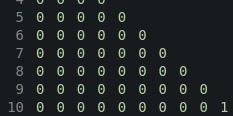
Row 2 of Rule 110 gets computed from row 1 on line 273:
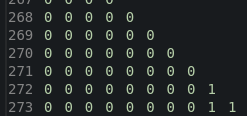
Row 3 of Rule 110 gets computed from row 1 on line 546:
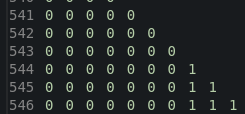
Row 4 of Rule 110 gets computed from row 1 on line 819:
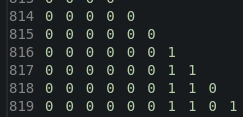
Row 5 of Rule 110 gets computed from row 1 on line 1092:
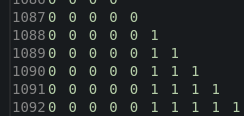
Row 6 of Rule 110 gets computed from row 1 on line 1365:
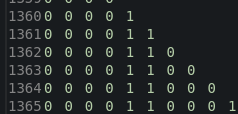
Row 7 of Rule 110 gets computed from row 1 on line 1638:

Row 8 of Rule 110 gets computed from row 1 on line 1911:

Row 9 of Rule 110 gets computed from row 1 on line 2184:
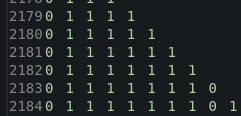
Row 10 of Rule 110 gets computed from row 1 on line 2457:
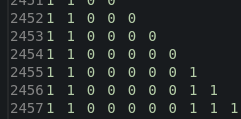
As a reminder, here is what the first 10 lines of Rule 110 look like when 9 0s and a 1 are supplied as input:

Here are the lines my bitcoin script computes (except it doesn’t compute the first one because it is given as input):
[row 1] 0 0 0 0 0 0 0 0 0 1
[row 2] 0 0 0 0 0 0 0 0 1 1
[row 3] 0 0 0 0 0 0 0 1 1 1
[row 4] 0 0 0 0 0 0 1 1 0 1
[row 5] 0 0 0 0 0 1 1 1 1 1
[row 6] 0 0 0 0 1 1 0 0 0 1
[row 7] 0 0 0 1 1 1 0 0 1 1
[row 8] 0 0 1 1 0 1 0 1 1 1
[row 9] 0 1 1 1 1 1 1 1 0 1
[row 10] 1 1 0 0 0 0 0 1 1 1
More code for playing with in the IDE
The following script computes the first 3 lines of Rule 110 when given a line of 3 <0>s and one <1> as input. It is what I ended up running directly on the blockchain in this transaction (except I had to remove the comments).
Put these first 5 lines in the “Stack Elements” pane of this IDE: https://ide.scriptwiz.app/
//The following items are inputs. The output of my program should be various lines of rule 110.
<0>
<0>
<0>
<1>
Put all of these lines in the “Witness Script” pane. The results should show up on the righthand side of the screen.
//Start generation 2
OP_0
//Duplicate the top three stack elements so that they become inputs to the rule 110 function
OP_3DUP
OP_SWAP
OP_IF
OP_BOOLAND
OP_NOT
OP_TOALTSTACK
OP_1
OP_ELSE
OP_TOALTSTACK
OP_ENDIF
//shift the tape to the right
OP_2DROP
//if we are nearing the end of the tape, add imaginary 0s to it
OP_DEPTH
OP_1
OP_EQUAL
OP_IF
OP_0
OP_SWAP
OP_ENDIF
OP_DEPTH
OP_2
OP_EQUAL
OP_IF
OP_0
OP_ROT
OP_ROT
OP_ENDIF
//Duplicate the top three stack elements so that they become inputs to the rule 110 function
OP_3DUP
OP_SWAP
OP_IF
OP_BOOLAND
OP_NOT
OP_TOALTSTACK
OP_1
OP_ELSE
OP_TOALTSTACK
OP_ENDIF
//shift the tape to the right
OP_2DROP
//if we are nearing the end of the tape, add imaginary 0s to it
OP_DEPTH
OP_1
OP_EQUAL
OP_IF
OP_0
OP_SWAP
OP_ENDIF
OP_DEPTH
OP_2
OP_EQUAL
OP_IF
OP_0
OP_ROT
OP_ROT
OP_ENDIF
//Duplicate the top three stack elements so that they become inputs to the rule 110 function
OP_3DUP
OP_SWAP
OP_IF
OP_BOOLAND
OP_NOT
OP_TOALTSTACK
OP_1
OP_ELSE
OP_TOALTSTACK
OP_ENDIF
//shift the tape to the right
OP_2DROP
//if we are nearing the end of the tape, add imaginary 0s to it
OP_DEPTH
OP_1
OP_EQUAL
OP_IF
OP_0
OP_SWAP
OP_ENDIF
OP_DEPTH
OP_2
OP_EQUAL
OP_IF
OP_0
OP_ROT
OP_ROT
OP_ENDIF
//Duplicate the top three stack elements so that they become inputs to the rule 110 function
OP_3DUP
OP_SWAP
OP_IF
OP_BOOLAND
OP_NOT
OP_TOALTSTACK
OP_1
OP_ELSE
OP_TOALTSTACK
OP_ENDIF
//shift the tape to the right
OP_2DROP
//if we are nearing the end of the tape, add imaginary 0s to it
OP_DEPTH
OP_1
OP_EQUAL
OP_IF
OP_0
OP_SWAP
OP_ENDIF
OP_DEPTH
OP_2
OP_EQUAL
OP_IF
OP_0
OP_ROT
OP_ROT
OP_ENDIF
OP_2DROP
OP_DROP
OP_FROMALTSTACK
OP_FROMALTSTACK
OP_FROMALTSTACK
OP_FROMALTSTACK
//Start generation 3
OP_0
//Duplicate the top three stack elements so that they become inputs to the rule 110 function
OP_3DUP
OP_SWAP
OP_IF
OP_BOOLAND
OP_NOT
OP_TOALTSTACK
OP_1
OP_ELSE
OP_TOALTSTACK
OP_ENDIF
//shift the tape to the right
OP_2DROP
//if we are nearing the end of the tape, add imaginary 0s to it
OP_DEPTH
OP_1
OP_EQUAL
OP_IF
OP_0
OP_SWAP
OP_ENDIF
OP_DEPTH
OP_2
OP_EQUAL
OP_IF
OP_0
OP_ROT
OP_ROT
OP_ENDIF
//Duplicate the top three stack elements so that they become inputs to the rule 110 function
OP_3DUP
OP_SWAP
OP_IF
OP_BOOLAND
OP_NOT
OP_TOALTSTACK
OP_1
OP_ELSE
OP_TOALTSTACK
OP_ENDIF
//shift the tape to the right
OP_2DROP
//if we are nearing the end of the tape, add imaginary 0s to it
OP_DEPTH
OP_1
OP_EQUAL
OP_IF
OP_0
OP_SWAP
OP_ENDIF
OP_DEPTH
OP_2
OP_EQUAL
OP_IF
OP_0
OP_ROT
OP_ROT
OP_ENDIF
//Duplicate the top three stack elements so that they become inputs to the rule 110 function
OP_3DUP
OP_SWAP
OP_IF
OP_BOOLAND
OP_NOT
OP_TOALTSTACK
OP_1
OP_ELSE
OP_TOALTSTACK
OP_ENDIF
//shift the tape to the right
OP_2DROP
//if we are nearing the end of the tape, add imaginary 0s to it
OP_DEPTH
OP_1
OP_EQUAL
OP_IF
OP_0
OP_SWAP
OP_ENDIF
OP_DEPTH
OP_2
OP_EQUAL
OP_IF
OP_0
OP_ROT
OP_ROT
OP_ENDIF
//Duplicate the top three stack elements so that they become inputs to the rule 110 function
OP_3DUP
OP_SWAP
OP_IF
OP_BOOLAND
OP_NOT
OP_TOALTSTACK
OP_1
OP_ELSE
OP_TOALTSTACK
OP_ENDIF
//shift the tape to the right
OP_2DROP
//if we are nearing the end of the tape, add imaginary 0s to it
OP_DEPTH
OP_1
OP_EQUAL
OP_IF
OP_0
OP_SWAP
OP_ENDIF
OP_DEPTH
OP_2
OP_EQUAL
OP_IF
OP_0
OP_ROT
OP_ROT
OP_ENDIF
OP_2DROP
OP_DROP
OP_FROMALTSTACK
OP_FROMALTSTACK
OP_FROMALTSTACK
OP_FROMALTSTACK
Longer version
What follows is a longer version of the script, without comments, that computes the first 10 lines of Rule 110. This longer version can’t run on the real bitcoin network because it uses more operations than bitcoin’s consensus rules permit in a single transaction. I include it here so you can experiment with it if you’re into coding, and so you can see that the small version that actually runs on the bitcoin network is doing the same computations as the large one, just fewer of them.
Put these first 11 lines in the “Stack Elements” pane of this IDE: https://ide.scriptwiz.app/
//The following items are inputs. The output of my program should be various lines of rule 110.
<0>
<0>
<0>
<0>
<0>
<0>
<0>
<0>
<0>
<1>
Put all of these lines in the “Witness Script” pane. The results should show up on the righthand side of the screen.
OP_0
OP_3DUP
OP_SWAP
OP_IF
OP_BOOLAND
OP_NOT
OP_TOALTSTACK
OP_1
OP_ELSE
OP_TOALTSTACK
OP_ENDIF
OP_2DROP
OP_DEPTH
OP_1
OP_EQUAL
OP_IF
OP_0
OP_SWAP
OP_ENDIF
OP_DEPTH
OP_2
OP_EQUAL
OP_IF
OP_0
OP_ROT
OP_ROT
OP_ENDIF
OP_3DUP
OP_SWAP
OP_IF
OP_BOOLAND
OP_NOT
OP_TOALTSTACK
OP_1
OP_ELSE
OP_TOALTSTACK
OP_ENDIF
OP_2DROP
OP_DEPTH
OP_1
OP_EQUAL
OP_IF
OP_0
OP_SWAP
OP_ENDIF
OP_DEPTH
OP_2
OP_EQUAL
OP_IF
OP_0
OP_ROT
OP_ROT
OP_ENDIF
OP_3DUP
OP_SWAP
OP_IF
OP_BOOLAND
OP_NOT
OP_TOALTSTACK
OP_1
OP_ELSE
OP_TOALTSTACK
OP_ENDIF
OP_2DROP
OP_DEPTH
OP_1
OP_EQUAL
OP_IF
OP_0
OP_SWAP
OP_ENDIF
OP_DEPTH
OP_2
OP_EQUAL
OP_IF
OP_0
OP_ROT
OP_ROT
OP_ENDIF
OP_3DUP
OP_SWAP
OP_IF
OP_BOOLAND
OP_NOT
OP_TOALTSTACK
OP_1
OP_ELSE
OP_TOALTSTACK
OP_ENDIF
OP_2DROP
OP_DEPTH
OP_1
OP_EQUAL
OP_IF
OP_0
OP_SWAP
OP_ENDIF
OP_DEPTH
OP_2
OP_EQUAL
OP_IF
OP_0
OP_ROT
OP_ROT
OP_ENDIF
OP_3DUP
OP_SWAP
OP_IF
OP_BOOLAND
OP_NOT
OP_TOALTSTACK
OP_1
OP_ELSE
OP_TOALTSTACK
OP_ENDIF
OP_2DROP
OP_DEPTH
OP_1
OP_EQUAL
OP_IF
OP_0
OP_SWAP
OP_ENDIF
OP_DEPTH
OP_2
OP_EQUAL
OP_IF
OP_0
OP_ROT
OP_ROT
OP_ENDIF
OP_3DUP
OP_SWAP
OP_IF
OP_BOOLAND
OP_NOT
OP_TOALTSTACK
OP_1
OP_ELSE
OP_TOALTSTACK
OP_ENDIF
OP_2DROP
OP_DEPTH
OP_1
OP_EQUAL
OP_IF
OP_0
OP_SWAP
OP_ENDIF
OP_DEPTH
OP_2
OP_EQUAL
OP_IF
OP_0
OP_ROT
OP_ROT
OP_ENDIF
OP_3DUP
OP_SWAP
OP_IF
OP_BOOLAND
OP_NOT
OP_TOALTSTACK
OP_1
OP_ELSE
OP_TOALTSTACK
OP_ENDIF
OP_2DROP
OP_DEPTH
OP_1
OP_EQUAL
OP_IF
OP_0
OP_SWAP
OP_ENDIF
OP_DEPTH
OP_2
OP_EQUAL
OP_IF
OP_0
OP_ROT
OP_ROT
OP_ENDIF
OP_3DUP
OP_SWAP
OP_IF
OP_BOOLAND
OP_NOT
OP_TOALTSTACK
OP_1
OP_ELSE
OP_TOALTSTACK
OP_ENDIF
OP_2DROP
OP_DEPTH
OP_1
OP_EQUAL
OP_IF
OP_0
OP_SWAP
OP_ENDIF
OP_DEPTH
OP_2
OP_EQUAL
OP_IF
OP_0
OP_ROT
OP_ROT
OP_ENDIF
OP_3DUP
OP_SWAP
OP_IF
OP_BOOLAND
OP_NOT
OP_TOALTSTACK
OP_1
OP_ELSE
OP_TOALTSTACK
OP_ENDIF
OP_2DROP
OP_DEPTH
OP_1
OP_EQUAL
OP_IF
OP_0
OP_SWAP
OP_ENDIF
OP_DEPTH
OP_2
OP_EQUAL
OP_IF
OP_0
OP_ROT
OP_ROT
OP_ENDIF
OP_3DUP
OP_SWAP
OP_IF
OP_BOOLAND
OP_NOT
OP_TOALTSTACK
OP_1
OP_ELSE
OP_TOALTSTACK
OP_ENDIF
OP_2DROP
OP_DEPTH
OP_1
OP_EQUAL
OP_IF
OP_0
OP_SWAP
OP_ENDIF
OP_DEPTH
OP_2
OP_EQUAL
OP_IF
OP_0
OP_ROT
OP_ROT
OP_ENDIF
OP_2DROP
OP_DROP
OP_FROMALTSTACK
OP_FROMALTSTACK
OP_FROMALTSTACK
OP_FROMALTSTACK
OP_FROMALTSTACK
OP_FROMALTSTACK
OP_FROMALTSTACK
OP_FROMALTSTACK
OP_FROMALTSTACK
OP_FROMALTSTACK
OP_0
OP_3DUP
OP_SWAP
OP_IF
OP_BOOLAND
OP_NOT
OP_TOALTSTACK
OP_1
OP_ELSE
OP_TOALTSTACK
OP_ENDIF
OP_2DROP
OP_DEPTH
OP_1
OP_EQUAL
OP_IF
OP_0
OP_SWAP
OP_ENDIF
OP_DEPTH
OP_2
OP_EQUAL
OP_IF
OP_0
OP_ROT
OP_ROT
OP_ENDIF
OP_3DUP
OP_SWAP
OP_IF
OP_BOOLAND
OP_NOT
OP_TOALTSTACK
OP_1
OP_ELSE
OP_TOALTSTACK
OP_ENDIF
OP_2DROP
OP_DEPTH
OP_1
OP_EQUAL
OP_IF
OP_0
OP_SWAP
OP_ENDIF
OP_DEPTH
OP_2
OP_EQUAL
OP_IF
OP_0
OP_ROT
OP_ROT
OP_ENDIF
OP_3DUP
OP_SWAP
OP_IF
OP_BOOLAND
OP_NOT
OP_TOALTSTACK
OP_1
OP_ELSE
OP_TOALTSTACK
OP_ENDIF
OP_2DROP
OP_DEPTH
OP_1
OP_EQUAL
OP_IF
OP_0
OP_SWAP
OP_ENDIF
OP_DEPTH
OP_2
OP_EQUAL
OP_IF
OP_0
OP_ROT
OP_ROT
OP_ENDIF
OP_3DUP
OP_SWAP
OP_IF
OP_BOOLAND
OP_NOT
OP_TOALTSTACK
OP_1
OP_ELSE
OP_TOALTSTACK
OP_ENDIF
OP_2DROP
OP_DEPTH
OP_1
OP_EQUAL
OP_IF
OP_0
OP_SWAP
OP_ENDIF
OP_DEPTH
OP_2
OP_EQUAL
OP_IF
OP_0
OP_ROT
OP_ROT
OP_ENDIF
OP_3DUP
OP_SWAP
OP_IF
OP_BOOLAND
OP_NOT
OP_TOALTSTACK
OP_1
OP_ELSE
OP_TOALTSTACK
OP_ENDIF
OP_2DROP
OP_DEPTH
OP_1
OP_EQUAL
OP_IF
OP_0
OP_SWAP
OP_ENDIF
OP_DEPTH
OP_2
OP_EQUAL
OP_IF
OP_0
OP_ROT
OP_ROT
OP_ENDIF
OP_3DUP
OP_SWAP
OP_IF
OP_BOOLAND
OP_NOT
OP_TOALTSTACK
OP_1
OP_ELSE
OP_TOALTSTACK
OP_ENDIF
OP_2DROP
OP_DEPTH
OP_1
OP_EQUAL
OP_IF
OP_0
OP_SWAP
OP_ENDIF
OP_DEPTH
OP_2
OP_EQUAL
OP_IF
OP_0
OP_ROT
OP_ROT
OP_ENDIF
OP_3DUP
OP_SWAP
OP_IF
OP_BOOLAND
OP_NOT
OP_TOALTSTACK
OP_1
OP_ELSE
OP_TOALTSTACK
OP_ENDIF
OP_2DROP
OP_DEPTH
OP_1
OP_EQUAL
OP_IF
OP_0
OP_SWAP
OP_ENDIF
OP_DEPTH
OP_2
OP_EQUAL
OP_IF
OP_0
OP_ROT
OP_ROT
OP_ENDIF
OP_3DUP
OP_SWAP
OP_IF
OP_BOOLAND
OP_NOT
OP_TOALTSTACK
OP_1
OP_ELSE
OP_TOALTSTACK
OP_ENDIF
OP_2DROP
OP_DEPTH
OP_1
OP_EQUAL
OP_IF
OP_0
OP_SWAP
OP_ENDIF
OP_DEPTH
OP_2
OP_EQUAL
OP_IF
OP_0
OP_ROT
OP_ROT
OP_ENDIF
OP_3DUP
OP_SWAP
OP_IF
OP_BOOLAND
OP_NOT
OP_TOALTSTACK
OP_1
OP_ELSE
OP_TOALTSTACK
OP_ENDIF
OP_2DROP
OP_DEPTH
OP_1
OP_EQUAL
OP_IF
OP_0
OP_SWAP
OP_ENDIF
OP_DEPTH
OP_2
OP_EQUAL
OP_IF
OP_0
OP_ROT
OP_ROT
OP_ENDIF
OP_3DUP
OP_SWAP
OP_IF
OP_BOOLAND
OP_NOT
OP_TOALTSTACK
OP_1
OP_ELSE
OP_TOALTSTACK
OP_ENDIF
OP_2DROP
OP_DEPTH
OP_1
OP_EQUAL
OP_IF
OP_0
OP_SWAP
OP_ENDIF
OP_DEPTH
OP_2
OP_EQUAL
OP_IF
OP_0
OP_ROT
OP_ROT
OP_ENDIF
OP_2DROP
OP_DROP
OP_FROMALTSTACK
OP_FROMALTSTACK
OP_FROMALTSTACK
OP_FROMALTSTACK
OP_FROMALTSTACK
OP_FROMALTSTACK
OP_FROMALTSTACK
OP_FROMALTSTACK
OP_FROMALTSTACK
OP_FROMALTSTACK
OP_0
OP_3DUP
OP_SWAP
OP_IF
OP_BOOLAND
OP_NOT
OP_TOALTSTACK
OP_1
OP_ELSE
OP_TOALTSTACK
OP_ENDIF
OP_2DROP
OP_DEPTH
OP_1
OP_EQUAL
OP_IF
OP_0
OP_SWAP
OP_ENDIF
OP_DEPTH
OP_2
OP_EQUAL
OP_IF
OP_0
OP_ROT
OP_ROT
OP_ENDIF
OP_3DUP
OP_SWAP
OP_IF
OP_BOOLAND
OP_NOT
OP_TOALTSTACK
OP_1
OP_ELSE
OP_TOALTSTACK
OP_ENDIF
OP_2DROP
OP_DEPTH
OP_1
OP_EQUAL
OP_IF
OP_0
OP_SWAP
OP_ENDIF
OP_DEPTH
OP_2
OP_EQUAL
OP_IF
OP_0
OP_ROT
OP_ROT
OP_ENDIF
OP_3DUP
OP_SWAP
OP_IF
OP_BOOLAND
OP_NOT
OP_TOALTSTACK
OP_1
OP_ELSE
OP_TOALTSTACK
OP_ENDIF
OP_2DROP
OP_DEPTH
OP_1
OP_EQUAL
OP_IF
OP_0
OP_SWAP
OP_ENDIF
OP_DEPTH
OP_2
OP_EQUAL
OP_IF
OP_0
OP_ROT
OP_ROT
OP_ENDIF
OP_3DUP
OP_SWAP
OP_IF
OP_BOOLAND
OP_NOT
OP_TOALTSTACK
OP_1
OP_ELSE
OP_TOALTSTACK
OP_ENDIF
OP_2DROP
OP_DEPTH
OP_1
OP_EQUAL
OP_IF
OP_0
OP_SWAP
OP_ENDIF
OP_DEPTH
OP_2
OP_EQUAL
OP_IF
OP_0
OP_ROT
OP_ROT
OP_ENDIF
OP_3DUP
OP_SWAP
OP_IF
OP_BOOLAND
OP_NOT
OP_TOALTSTACK
OP_1
OP_ELSE
OP_TOALTSTACK
OP_ENDIF
OP_2DROP
OP_DEPTH
OP_1
OP_EQUAL
OP_IF
OP_0
OP_SWAP
OP_ENDIF
OP_DEPTH
OP_2
OP_EQUAL
OP_IF
OP_0
OP_ROT
OP_ROT
OP_ENDIF
OP_3DUP
OP_SWAP
OP_IF
OP_BOOLAND
OP_NOT
OP_TOALTSTACK
OP_1
OP_ELSE
OP_TOALTSTACK
OP_ENDIF
OP_2DROP
OP_DEPTH
OP_1
OP_EQUAL
OP_IF
OP_0
OP_SWAP
OP_ENDIF
OP_DEPTH
OP_2
OP_EQUAL
OP_IF
OP_0
OP_ROT
OP_ROT
OP_ENDIF
OP_3DUP
OP_SWAP
OP_IF
OP_BOOLAND
OP_NOT
OP_TOALTSTACK
OP_1
OP_ELSE
OP_TOALTSTACK
OP_ENDIF
OP_2DROP
OP_DEPTH
OP_1
OP_EQUAL
OP_IF
OP_0
OP_SWAP
OP_ENDIF
OP_DEPTH
OP_2
OP_EQUAL
OP_IF
OP_0
OP_ROT
OP_ROT
OP_ENDIF
OP_3DUP
OP_SWAP
OP_IF
OP_BOOLAND
OP_NOT
OP_TOALTSTACK
OP_1
OP_ELSE
OP_TOALTSTACK
OP_ENDIF
OP_2DROP
OP_DEPTH
OP_1
OP_EQUAL
OP_IF
OP_0
OP_SWAP
OP_ENDIF
OP_DEPTH
OP_2
OP_EQUAL
OP_IF
OP_0
OP_ROT
OP_ROT
OP_ENDIF
OP_3DUP
OP_SWAP
OP_IF
OP_BOOLAND
OP_NOT
OP_TOALTSTACK
OP_1
OP_ELSE
OP_TOALTSTACK
OP_ENDIF
OP_2DROP
OP_DEPTH
OP_1
OP_EQUAL
OP_IF
OP_0
OP_SWAP
OP_ENDIF
OP_DEPTH
OP_2
OP_EQUAL
OP_IF
OP_0
OP_ROT
OP_ROT
OP_ENDIF
OP_3DUP
OP_SWAP
OP_IF
OP_BOOLAND
OP_NOT
OP_TOALTSTACK
OP_1
OP_ELSE
OP_TOALTSTACK
OP_ENDIF
OP_2DROP
OP_DEPTH
OP_1
OP_EQUAL
OP_IF
OP_0
OP_SWAP
OP_ENDIF
OP_DEPTH
OP_2
OP_EQUAL
OP_IF
OP_0
OP_ROT
OP_ROT
OP_ENDIF
OP_2DROP
OP_DROP
OP_FROMALTSTACK
OP_FROMALTSTACK
OP_FROMALTSTACK
OP_FROMALTSTACK
OP_FROMALTSTACK
OP_FROMALTSTACK
OP_FROMALTSTACK
OP_FROMALTSTACK
OP_FROMALTSTACK
OP_FROMALTSTACK
OP_0
OP_3DUP
OP_SWAP
OP_IF
OP_BOOLAND
OP_NOT
OP_TOALTSTACK
OP_1
OP_ELSE
OP_TOALTSTACK
OP_ENDIF
OP_2DROP
OP_DEPTH
OP_1
OP_EQUAL
OP_IF
OP_0
OP_SWAP
OP_ENDIF
OP_DEPTH
OP_2
OP_EQUAL
OP_IF
OP_0
OP_ROT
OP_ROT
OP_ENDIF
OP_3DUP
OP_SWAP
OP_IF
OP_BOOLAND
OP_NOT
OP_TOALTSTACK
OP_1
OP_ELSE
OP_TOALTSTACK
OP_ENDIF
OP_2DROP
OP_DEPTH
OP_1
OP_EQUAL
OP_IF
OP_0
OP_SWAP
OP_ENDIF
OP_DEPTH
OP_2
OP_EQUAL
OP_IF
OP_0
OP_ROT
OP_ROT
OP_ENDIF
OP_3DUP
OP_SWAP
OP_IF
OP_BOOLAND
OP_NOT
OP_TOALTSTACK
OP_1
OP_ELSE
OP_TOALTSTACK
OP_ENDIF
OP_2DROP
OP_DEPTH
OP_1
OP_EQUAL
OP_IF
OP_0
OP_SWAP
OP_ENDIF
OP_DEPTH
OP_2
OP_EQUAL
OP_IF
OP_0
OP_ROT
OP_ROT
OP_ENDIF
OP_3DUP
OP_SWAP
OP_IF
OP_BOOLAND
OP_NOT
OP_TOALTSTACK
OP_1
OP_ELSE
OP_TOALTSTACK
OP_ENDIF
OP_2DROP
OP_DEPTH
OP_1
OP_EQUAL
OP_IF
OP_0
OP_SWAP
OP_ENDIF
OP_DEPTH
OP_2
OP_EQUAL
OP_IF
OP_0
OP_ROT
OP_ROT
OP_ENDIF
OP_3DUP
OP_SWAP
OP_IF
OP_BOOLAND
OP_NOT
OP_TOALTSTACK
OP_1
OP_ELSE
OP_TOALTSTACK
OP_ENDIF
OP_2DROP
OP_DEPTH
OP_1
OP_EQUAL
OP_IF
OP_0
OP_SWAP
OP_ENDIF
OP_DEPTH
OP_2
OP_EQUAL
OP_IF
OP_0
OP_ROT
OP_ROT
OP_ENDIF
OP_3DUP
OP_SWAP
OP_IF
OP_BOOLAND
OP_NOT
OP_TOALTSTACK
OP_1
OP_ELSE
OP_TOALTSTACK
OP_ENDIF
OP_2DROP
OP_DEPTH
OP_1
OP_EQUAL
OP_IF
OP_0
OP_SWAP
OP_ENDIF
OP_DEPTH
OP_2
OP_EQUAL
OP_IF
OP_0
OP_ROT
OP_ROT
OP_ENDIF
OP_3DUP
OP_SWAP
OP_IF
OP_BOOLAND
OP_NOT
OP_TOALTSTACK
OP_1
OP_ELSE
OP_TOALTSTACK
OP_ENDIF
OP_2DROP
OP_DEPTH
OP_1
OP_EQUAL
OP_IF
OP_0
OP_SWAP
OP_ENDIF
OP_DEPTH
OP_2
OP_EQUAL
OP_IF
OP_0
OP_ROT
OP_ROT
OP_ENDIF
OP_3DUP
OP_SWAP
OP_IF
OP_BOOLAND
OP_NOT
OP_TOALTSTACK
OP_1
OP_ELSE
OP_TOALTSTACK
OP_ENDIF
OP_2DROP
OP_DEPTH
OP_1
OP_EQUAL
OP_IF
OP_0
OP_SWAP
OP_ENDIF
OP_DEPTH
OP_2
OP_EQUAL
OP_IF
OP_0
OP_ROT
OP_ROT
OP_ENDIF
OP_3DUP
OP_SWAP
OP_IF
OP_BOOLAND
OP_NOT
OP_TOALTSTACK
OP_1
OP_ELSE
OP_TOALTSTACK
OP_ENDIF
OP_2DROP
OP_DEPTH
OP_1
OP_EQUAL
OP_IF
OP_0
OP_SWAP
OP_ENDIF
OP_DEPTH
OP_2
OP_EQUAL
OP_IF
OP_0
OP_ROT
OP_ROT
OP_ENDIF
OP_3DUP
OP_SWAP
OP_IF
OP_BOOLAND
OP_NOT
OP_TOALTSTACK
OP_1
OP_ELSE
OP_TOALTSTACK
OP_ENDIF
OP_2DROP
OP_DEPTH
OP_1
OP_EQUAL
OP_IF
OP_0
OP_SWAP
OP_ENDIF
OP_DEPTH
OP_2
OP_EQUAL
OP_IF
OP_0
OP_ROT
OP_ROT
OP_ENDIF
OP_2DROP
OP_DROP
OP_FROMALTSTACK
OP_FROMALTSTACK
OP_FROMALTSTACK
OP_FROMALTSTACK
OP_FROMALTSTACK
OP_FROMALTSTACK
OP_FROMALTSTACK
OP_FROMALTSTACK
OP_FROMALTSTACK
OP_FROMALTSTACK
OP_0
OP_3DUP
OP_SWAP
OP_IF
OP_BOOLAND
OP_NOT
OP_TOALTSTACK
OP_1
OP_ELSE
OP_TOALTSTACK
OP_ENDIF
OP_2DROP
OP_DEPTH
OP_1
OP_EQUAL
OP_IF
OP_0
OP_SWAP
OP_ENDIF
OP_DEPTH
OP_2
OP_EQUAL
OP_IF
OP_0
OP_ROT
OP_ROT
OP_ENDIF
OP_3DUP
OP_SWAP
OP_IF
OP_BOOLAND
OP_NOT
OP_TOALTSTACK
OP_1
OP_ELSE
OP_TOALTSTACK
OP_ENDIF
OP_2DROP
OP_DEPTH
OP_1
OP_EQUAL
OP_IF
OP_0
OP_SWAP
OP_ENDIF
OP_DEPTH
OP_2
OP_EQUAL
OP_IF
OP_0
OP_ROT
OP_ROT
OP_ENDIF
OP_3DUP
OP_SWAP
OP_IF
OP_BOOLAND
OP_NOT
OP_TOALTSTACK
OP_1
OP_ELSE
OP_TOALTSTACK
OP_ENDIF
OP_2DROP
OP_DEPTH
OP_1
OP_EQUAL
OP_IF
OP_0
OP_SWAP
OP_ENDIF
OP_DEPTH
OP_2
OP_EQUAL
OP_IF
OP_0
OP_ROT
OP_ROT
OP_ENDIF
OP_3DUP
OP_SWAP
OP_IF
OP_BOOLAND
OP_NOT
OP_TOALTSTACK
OP_1
OP_ELSE
OP_TOALTSTACK
OP_ENDIF
OP_2DROP
OP_DEPTH
OP_1
OP_EQUAL
OP_IF
OP_0
OP_SWAP
OP_ENDIF
OP_DEPTH
OP_2
OP_EQUAL
OP_IF
OP_0
OP_ROT
OP_ROT
OP_ENDIF
OP_3DUP
OP_SWAP
OP_IF
OP_BOOLAND
OP_NOT
OP_TOALTSTACK
OP_1
OP_ELSE
OP_TOALTSTACK
OP_ENDIF
OP_2DROP
OP_DEPTH
OP_1
OP_EQUAL
OP_IF
OP_0
OP_SWAP
OP_ENDIF
OP_DEPTH
OP_2
OP_EQUAL
OP_IF
OP_0
OP_ROT
OP_ROT
OP_ENDIF
OP_3DUP
OP_SWAP
OP_IF
OP_BOOLAND
OP_NOT
OP_TOALTSTACK
OP_1
OP_ELSE
OP_TOALTSTACK
OP_ENDIF
OP_2DROP
OP_DEPTH
OP_1
OP_EQUAL
OP_IF
OP_0
OP_SWAP
OP_ENDIF
OP_DEPTH
OP_2
OP_EQUAL
OP_IF
OP_0
OP_ROT
OP_ROT
OP_ENDIF
OP_3DUP
OP_SWAP
OP_IF
OP_BOOLAND
OP_NOT
OP_TOALTSTACK
OP_1
OP_ELSE
OP_TOALTSTACK
OP_ENDIF
OP_2DROP
OP_DEPTH
OP_1
OP_EQUAL
OP_IF
OP_0
OP_SWAP
OP_ENDIF
OP_DEPTH
OP_2
OP_EQUAL
OP_IF
OP_0
OP_ROT
OP_ROT
OP_ENDIF
OP_3DUP
OP_SWAP
OP_IF
OP_BOOLAND
OP_NOT
OP_TOALTSTACK
OP_1
OP_ELSE
OP_TOALTSTACK
OP_ENDIF
OP_2DROP
OP_DEPTH
OP_1
OP_EQUAL
OP_IF
OP_0
OP_SWAP
OP_ENDIF
OP_DEPTH
OP_2
OP_EQUAL
OP_IF
OP_0
OP_ROT
OP_ROT
OP_ENDIF
OP_3DUP
OP_SWAP
OP_IF
OP_BOOLAND
OP_NOT
OP_TOALTSTACK
OP_1
OP_ELSE
OP_TOALTSTACK
OP_ENDIF
OP_2DROP
OP_DEPTH
OP_1
OP_EQUAL
OP_IF
OP_0
OP_SWAP
OP_ENDIF
OP_DEPTH
OP_2
OP_EQUAL
OP_IF
OP_0
OP_ROT
OP_ROT
OP_ENDIF
OP_3DUP
OP_SWAP
OP_IF
OP_BOOLAND
OP_NOT
OP_TOALTSTACK
OP_1
OP_ELSE
OP_TOALTSTACK
OP_ENDIF
OP_2DROP
OP_DEPTH
OP_1
OP_EQUAL
OP_IF
OP_0
OP_SWAP
OP_ENDIF
OP_DEPTH
OP_2
OP_EQUAL
OP_IF
OP_0
OP_ROT
OP_ROT
OP_ENDIF
OP_2DROP
OP_DROP
OP_FROMALTSTACK
OP_FROMALTSTACK
OP_FROMALTSTACK
OP_FROMALTSTACK
OP_FROMALTSTACK
OP_FROMALTSTACK
OP_FROMALTSTACK
OP_FROMALTSTACK
OP_FROMALTSTACK
OP_FROMALTSTACK
OP_0
OP_3DUP
OP_SWAP
OP_IF
OP_BOOLAND
OP_NOT
OP_TOALTSTACK
OP_1
OP_ELSE
OP_TOALTSTACK
OP_ENDIF
OP_2DROP
OP_DEPTH
OP_1
OP_EQUAL
OP_IF
OP_0
OP_SWAP
OP_ENDIF
OP_DEPTH
OP_2
OP_EQUAL
OP_IF
OP_0
OP_ROT
OP_ROT
OP_ENDIF
OP_3DUP
OP_SWAP
OP_IF
OP_BOOLAND
OP_NOT
OP_TOALTSTACK
OP_1
OP_ELSE
OP_TOALTSTACK
OP_ENDIF
OP_2DROP
OP_DEPTH
OP_1
OP_EQUAL
OP_IF
OP_0
OP_SWAP
OP_ENDIF
OP_DEPTH
OP_2
OP_EQUAL
OP_IF
OP_0
OP_ROT
OP_ROT
OP_ENDIF
OP_3DUP
OP_SWAP
OP_IF
OP_BOOLAND
OP_NOT
OP_TOALTSTACK
OP_1
OP_ELSE
OP_TOALTSTACK
OP_ENDIF
OP_2DROP
OP_DEPTH
OP_1
OP_EQUAL
OP_IF
OP_0
OP_SWAP
OP_ENDIF
OP_DEPTH
OP_2
OP_EQUAL
OP_IF
OP_0
OP_ROT
OP_ROT
OP_ENDIF
OP_3DUP
OP_SWAP
OP_IF
OP_BOOLAND
OP_NOT
OP_TOALTSTACK
OP_1
OP_ELSE
OP_TOALTSTACK
OP_ENDIF
OP_2DROP
OP_DEPTH
OP_1
OP_EQUAL
OP_IF
OP_0
OP_SWAP
OP_ENDIF
OP_DEPTH
OP_2
OP_EQUAL
OP_IF
OP_0
OP_ROT
OP_ROT
OP_ENDIF
OP_3DUP
OP_SWAP
OP_IF
OP_BOOLAND
OP_NOT
OP_TOALTSTACK
OP_1
OP_ELSE
OP_TOALTSTACK
OP_ENDIF
OP_2DROP
OP_DEPTH
OP_1
OP_EQUAL
OP_IF
OP_0
OP_SWAP
OP_ENDIF
OP_DEPTH
OP_2
OP_EQUAL
OP_IF
OP_0
OP_ROT
OP_ROT
OP_ENDIF
OP_3DUP
OP_SWAP
OP_IF
OP_BOOLAND
OP_NOT
OP_TOALTSTACK
OP_1
OP_ELSE
OP_TOALTSTACK
OP_ENDIF
OP_2DROP
OP_DEPTH
OP_1
OP_EQUAL
OP_IF
OP_0
OP_SWAP
OP_ENDIF
OP_DEPTH
OP_2
OP_EQUAL
OP_IF
OP_0
OP_ROT
OP_ROT
OP_ENDIF
OP_3DUP
OP_SWAP
OP_IF
OP_BOOLAND
OP_NOT
OP_TOALTSTACK
OP_1
OP_ELSE
OP_TOALTSTACK
OP_ENDIF
OP_2DROP
OP_DEPTH
OP_1
OP_EQUAL
OP_IF
OP_0
OP_SWAP
OP_ENDIF
OP_DEPTH
OP_2
OP_EQUAL
OP_IF
OP_0
OP_ROT
OP_ROT
OP_ENDIF
OP_3DUP
OP_SWAP
OP_IF
OP_BOOLAND
OP_NOT
OP_TOALTSTACK
OP_1
OP_ELSE
OP_TOALTSTACK
OP_ENDIF
OP_2DROP
OP_DEPTH
OP_1
OP_EQUAL
OP_IF
OP_0
OP_SWAP
OP_ENDIF
OP_DEPTH
OP_2
OP_EQUAL
OP_IF
OP_0
OP_ROT
OP_ROT
OP_ENDIF
OP_3DUP
OP_SWAP
OP_IF
OP_BOOLAND
OP_NOT
OP_TOALTSTACK
OP_1
OP_ELSE
OP_TOALTSTACK
OP_ENDIF
OP_2DROP
OP_DEPTH
OP_1
OP_EQUAL
OP_IF
OP_0
OP_SWAP
OP_ENDIF
OP_DEPTH
OP_2
OP_EQUAL
OP_IF
OP_0
OP_ROT
OP_ROT
OP_ENDIF
OP_3DUP
OP_SWAP
OP_IF
OP_BOOLAND
OP_NOT
OP_TOALTSTACK
OP_1
OP_ELSE
OP_TOALTSTACK
OP_ENDIF
OP_2DROP
OP_DEPTH
OP_1
OP_EQUAL
OP_IF
OP_0
OP_SWAP
OP_ENDIF
OP_DEPTH
OP_2
OP_EQUAL
OP_IF
OP_0
OP_ROT
OP_ROT
OP_ENDIF
OP_2DROP
OP_DROP
OP_FROMALTSTACK
OP_FROMALTSTACK
OP_FROMALTSTACK
OP_FROMALTSTACK
OP_FROMALTSTACK
OP_FROMALTSTACK
OP_FROMALTSTACK
OP_FROMALTSTACK
OP_FROMALTSTACK
OP_FROMALTSTACK
OP_0
OP_3DUP
OP_SWAP
OP_IF
OP_BOOLAND
OP_NOT
OP_TOALTSTACK
OP_1
OP_ELSE
OP_TOALTSTACK
OP_ENDIF
OP_2DROP
OP_DEPTH
OP_1
OP_EQUAL
OP_IF
OP_0
OP_SWAP
OP_ENDIF
OP_DEPTH
OP_2
OP_EQUAL
OP_IF
OP_0
OP_ROT
OP_ROT
OP_ENDIF
OP_3DUP
OP_SWAP
OP_IF
OP_BOOLAND
OP_NOT
OP_TOALTSTACK
OP_1
OP_ELSE
OP_TOALTSTACK
OP_ENDIF
OP_2DROP
OP_DEPTH
OP_1
OP_EQUAL
OP_IF
OP_0
OP_SWAP
OP_ENDIF
OP_DEPTH
OP_2
OP_EQUAL
OP_IF
OP_0
OP_ROT
OP_ROT
OP_ENDIF
OP_3DUP
OP_SWAP
OP_IF
OP_BOOLAND
OP_NOT
OP_TOALTSTACK
OP_1
OP_ELSE
OP_TOALTSTACK
OP_ENDIF
OP_2DROP
OP_DEPTH
OP_1
OP_EQUAL
OP_IF
OP_0
OP_SWAP
OP_ENDIF
OP_DEPTH
OP_2
OP_EQUAL
OP_IF
OP_0
OP_ROT
OP_ROT
OP_ENDIF
OP_3DUP
OP_SWAP
OP_IF
OP_BOOLAND
OP_NOT
OP_TOALTSTACK
OP_1
OP_ELSE
OP_TOALTSTACK
OP_ENDIF
OP_2DROP
OP_DEPTH
OP_1
OP_EQUAL
OP_IF
OP_0
OP_SWAP
OP_ENDIF
OP_DEPTH
OP_2
OP_EQUAL
OP_IF
OP_0
OP_ROT
OP_ROT
OP_ENDIF
OP_3DUP
OP_SWAP
OP_IF
OP_BOOLAND
OP_NOT
OP_TOALTSTACK
OP_1
OP_ELSE
OP_TOALTSTACK
OP_ENDIF
OP_2DROP
OP_DEPTH
OP_1
OP_EQUAL
OP_IF
OP_0
OP_SWAP
OP_ENDIF
OP_DEPTH
OP_2
OP_EQUAL
OP_IF
OP_0
OP_ROT
OP_ROT
OP_ENDIF
OP_3DUP
OP_SWAP
OP_IF
OP_BOOLAND
OP_NOT
OP_TOALTSTACK
OP_1
OP_ELSE
OP_TOALTSTACK
OP_ENDIF
OP_2DROP
OP_DEPTH
OP_1
OP_EQUAL
OP_IF
OP_0
OP_SWAP
OP_ENDIF
OP_DEPTH
OP_2
OP_EQUAL
OP_IF
OP_0
OP_ROT
OP_ROT
OP_ENDIF
OP_3DUP
OP_SWAP
OP_IF
OP_BOOLAND
OP_NOT
OP_TOALTSTACK
OP_1
OP_ELSE
OP_TOALTSTACK
OP_ENDIF
OP_2DROP
OP_DEPTH
OP_1
OP_EQUAL
OP_IF
OP_0
OP_SWAP
OP_ENDIF
OP_DEPTH
OP_2
OP_EQUAL
OP_IF
OP_0
OP_ROT
OP_ROT
OP_ENDIF
OP_3DUP
OP_SWAP
OP_IF
OP_BOOLAND
OP_NOT
OP_TOALTSTACK
OP_1
OP_ELSE
OP_TOALTSTACK
OP_ENDIF
OP_2DROP
OP_DEPTH
OP_1
OP_EQUAL
OP_IF
OP_0
OP_SWAP
OP_ENDIF
OP_DEPTH
OP_2
OP_EQUAL
OP_IF
OP_0
OP_ROT
OP_ROT
OP_ENDIF
OP_3DUP
OP_SWAP
OP_IF
OP_BOOLAND
OP_NOT
OP_TOALTSTACK
OP_1
OP_ELSE
OP_TOALTSTACK
OP_ENDIF
OP_2DROP
OP_DEPTH
OP_1
OP_EQUAL
OP_IF
OP_0
OP_SWAP
OP_ENDIF
OP_DEPTH
OP_2
OP_EQUAL
OP_IF
OP_0
OP_ROT
OP_ROT
OP_ENDIF
OP_3DUP
OP_SWAP
OP_IF
OP_BOOLAND
OP_NOT
OP_TOALTSTACK
OP_1
OP_ELSE
OP_TOALTSTACK
OP_ENDIF
OP_2DROP
OP_DEPTH
OP_1
OP_EQUAL
OP_IF
OP_0
OP_SWAP
OP_ENDIF
OP_DEPTH
OP_2
OP_EQUAL
OP_IF
OP_0
OP_ROT
OP_ROT
OP_ENDIF
OP_2DROP
OP_DROP
OP_FROMALTSTACK
OP_FROMALTSTACK
OP_FROMALTSTACK
OP_FROMALTSTACK
OP_FROMALTSTACK
OP_FROMALTSTACK
OP_FROMALTSTACK
OP_FROMALTSTACK
OP_FROMALTSTACK
OP_FROMALTSTACK
OP_0
OP_3DUP
OP_SWAP
OP_IF
OP_BOOLAND
OP_NOT
OP_TOALTSTACK
OP_1
OP_ELSE
OP_TOALTSTACK
OP_ENDIF
OP_2DROP
OP_DEPTH
OP_1
OP_EQUAL
OP_IF
OP_0
OP_SWAP
OP_ENDIF
OP_DEPTH
OP_2
OP_EQUAL
OP_IF
OP_0
OP_ROT
OP_ROT
OP_ENDIF
OP_3DUP
OP_SWAP
OP_IF
OP_BOOLAND
OP_NOT
OP_TOALTSTACK
OP_1
OP_ELSE
OP_TOALTSTACK
OP_ENDIF
OP_2DROP
OP_DEPTH
OP_1
OP_EQUAL
OP_IF
OP_0
OP_SWAP
OP_ENDIF
OP_DEPTH
OP_2
OP_EQUAL
OP_IF
OP_0
OP_ROT
OP_ROT
OP_ENDIF
OP_3DUP
OP_SWAP
OP_IF
OP_BOOLAND
OP_NOT
OP_TOALTSTACK
OP_1
OP_ELSE
OP_TOALTSTACK
OP_ENDIF
OP_2DROP
OP_DEPTH
OP_1
OP_EQUAL
OP_IF
OP_0
OP_SWAP
OP_ENDIF
OP_DEPTH
OP_2
OP_EQUAL
OP_IF
OP_0
OP_ROT
OP_ROT
OP_ENDIF
OP_3DUP
OP_SWAP
OP_IF
OP_BOOLAND
OP_NOT
OP_TOALTSTACK
OP_1
OP_ELSE
OP_TOALTSTACK
OP_ENDIF
OP_2DROP
OP_DEPTH
OP_1
OP_EQUAL
OP_IF
OP_0
OP_SWAP
OP_ENDIF
OP_DEPTH
OP_2
OP_EQUAL
OP_IF
OP_0
OP_ROT
OP_ROT
OP_ENDIF
OP_3DUP
OP_SWAP
OP_IF
OP_BOOLAND
OP_NOT
OP_TOALTSTACK
OP_1
OP_ELSE
OP_TOALTSTACK
OP_ENDIF
OP_2DROP
OP_DEPTH
OP_1
OP_EQUAL
OP_IF
OP_0
OP_SWAP
OP_ENDIF
OP_DEPTH
OP_2
OP_EQUAL
OP_IF
OP_0
OP_ROT
OP_ROT
OP_ENDIF
OP_3DUP
OP_SWAP
OP_IF
OP_BOOLAND
OP_NOT
OP_TOALTSTACK
OP_1
OP_ELSE
OP_TOALTSTACK
OP_ENDIF
OP_2DROP
OP_DEPTH
OP_1
OP_EQUAL
OP_IF
OP_0
OP_SWAP
OP_ENDIF
OP_DEPTH
OP_2
OP_EQUAL
OP_IF
OP_0
OP_ROT
OP_ROT
OP_ENDIF
OP_3DUP
OP_SWAP
OP_IF
OP_BOOLAND
OP_NOT
OP_TOALTSTACK
OP_1
OP_ELSE
OP_TOALTSTACK
OP_ENDIF
OP_2DROP
OP_DEPTH
OP_1
OP_EQUAL
OP_IF
OP_0
OP_SWAP
OP_ENDIF
OP_DEPTH
OP_2
OP_EQUAL
OP_IF
OP_0
OP_ROT
OP_ROT
OP_ENDIF
OP_3DUP
OP_SWAP
OP_IF
OP_BOOLAND
OP_NOT
OP_TOALTSTACK
OP_1
OP_ELSE
OP_TOALTSTACK
OP_ENDIF
OP_2DROP
OP_DEPTH
OP_1
OP_EQUAL
OP_IF
OP_0
OP_SWAP
OP_ENDIF
OP_DEPTH
OP_2
OP_EQUAL
OP_IF
OP_0
OP_ROT
OP_ROT
OP_ENDIF
OP_3DUP
OP_SWAP
OP_IF
OP_BOOLAND
OP_NOT
OP_TOALTSTACK
OP_1
OP_ELSE
OP_TOALTSTACK
OP_ENDIF
OP_2DROP
OP_DEPTH
OP_1
OP_EQUAL
OP_IF
OP_0
OP_SWAP
OP_ENDIF
OP_DEPTH
OP_2
OP_EQUAL
OP_IF
OP_0
OP_ROT
OP_ROT
OP_ENDIF
OP_3DUP
OP_SWAP
OP_IF
OP_BOOLAND
OP_NOT
OP_TOALTSTACK
OP_1
OP_ELSE
OP_TOALTSTACK
OP_ENDIF
OP_2DROP
OP_DEPTH
OP_1
OP_EQUAL
OP_IF
OP_0
OP_SWAP
OP_ENDIF
OP_DEPTH
OP_2
OP_EQUAL
OP_IF
OP_0
OP_ROT
OP_ROT
OP_ENDIF
OP_2DROP
OP_DROP
OP_FROMALTSTACK
OP_FROMALTSTACK
OP_FROMALTSTACK
OP_FROMALTSTACK
OP_FROMALTSTACK
OP_FROMALTSTACK
OP_FROMALTSTACK
OP_FROMALTSTACK
OP_FROMALTSTACK
OP_FROMALTSTACK
OP_0
OP_3DUP
OP_SWAP
OP_IF
OP_BOOLAND
OP_NOT
OP_TOALTSTACK
OP_1
OP_ELSE
OP_TOALTSTACK
OP_ENDIF
OP_2DROP
OP_DEPTH
OP_1
OP_EQUAL
OP_IF
OP_0
OP_SWAP
OP_ENDIF
OP_DEPTH
OP_2
OP_EQUAL
OP_IF
OP_0
OP_ROT
OP_ROT
OP_ENDIF
OP_3DUP
OP_SWAP
OP_IF
OP_BOOLAND
OP_NOT
OP_TOALTSTACK
OP_1
OP_ELSE
OP_TOALTSTACK
OP_ENDIF
OP_2DROP
OP_DEPTH
OP_1
OP_EQUAL
OP_IF
OP_0
OP_SWAP
OP_ENDIF
OP_DEPTH
OP_2
OP_EQUAL
OP_IF
OP_0
OP_ROT
OP_ROT
OP_ENDIF
OP_3DUP
OP_SWAP
OP_IF
OP_BOOLAND
OP_NOT
OP_TOALTSTACK
OP_1
OP_ELSE
OP_TOALTSTACK
OP_ENDIF
OP_2DROP
OP_DEPTH
OP_1
OP_EQUAL
OP_IF
OP_0
OP_SWAP
OP_ENDIF
OP_DEPTH
OP_2
OP_EQUAL
OP_IF
OP_0
OP_ROT
OP_ROT
OP_ENDIF
OP_3DUP
OP_SWAP
OP_IF
OP_BOOLAND
OP_NOT
OP_TOALTSTACK
OP_1
OP_ELSE
OP_TOALTSTACK
OP_ENDIF
OP_2DROP
OP_DEPTH
OP_1
OP_EQUAL
OP_IF
OP_0
OP_SWAP
OP_ENDIF
OP_DEPTH
OP_2
OP_EQUAL
OP_IF
OP_0
OP_ROT
OP_ROT
OP_ENDIF
OP_3DUP
OP_SWAP
OP_IF
OP_BOOLAND
OP_NOT
OP_TOALTSTACK
OP_1
OP_ELSE
OP_TOALTSTACK
OP_ENDIF
OP_2DROP
OP_DEPTH
OP_1
OP_EQUAL
OP_IF
OP_0
OP_SWAP
OP_ENDIF
OP_DEPTH
OP_2
OP_EQUAL
OP_IF
OP_0
OP_ROT
OP_ROT
OP_ENDIF
OP_3DUP
OP_SWAP
OP_IF
OP_BOOLAND
OP_NOT
OP_TOALTSTACK
OP_1
OP_ELSE
OP_TOALTSTACK
OP_ENDIF
OP_2DROP
OP_DEPTH
OP_1
OP_EQUAL
OP_IF
OP_0
OP_SWAP
OP_ENDIF
OP_DEPTH
OP_2
OP_EQUAL
OP_IF
OP_0
OP_ROT
OP_ROT
OP_ENDIF
OP_3DUP
OP_SWAP
OP_IF
OP_BOOLAND
OP_NOT
OP_TOALTSTACK
OP_1
OP_ELSE
OP_TOALTSTACK
OP_ENDIF
OP_2DROP
OP_DEPTH
OP_1
OP_EQUAL
OP_IF
OP_0
OP_SWAP
OP_ENDIF
OP_DEPTH
OP_2
OP_EQUAL
OP_IF
OP_0
OP_ROT
OP_ROT
OP_ENDIF
OP_3DUP
OP_SWAP
OP_IF
OP_BOOLAND
OP_NOT
OP_TOALTSTACK
OP_1
OP_ELSE
OP_TOALTSTACK
OP_ENDIF
OP_2DROP
OP_DEPTH
OP_1
OP_EQUAL
OP_IF
OP_0
OP_SWAP
OP_ENDIF
OP_DEPTH
OP_2
OP_EQUAL
OP_IF
OP_0
OP_ROT
OP_ROT
OP_ENDIF
OP_3DUP
OP_SWAP
OP_IF
OP_BOOLAND
OP_NOT
OP_TOALTSTACK
OP_1
OP_ELSE
OP_TOALTSTACK
OP_ENDIF
OP_2DROP
OP_DEPTH
OP_1
OP_EQUAL
OP_IF
OP_0
OP_SWAP
OP_ENDIF
OP_DEPTH
OP_2
OP_EQUAL
OP_IF
OP_0
OP_ROT
OP_ROT
OP_ENDIF
OP_3DUP
OP_SWAP
OP_IF
OP_BOOLAND
OP_NOT
OP_TOALTSTACK
OP_1
OP_ELSE
OP_TOALTSTACK
OP_ENDIF
OP_2DROP
OP_DEPTH
OP_1
OP_EQUAL
OP_IF
OP_0
OP_SWAP
OP_ENDIF
OP_DEPTH
OP_2
OP_EQUAL
OP_IF
OP_0
OP_ROT
OP_ROT
OP_ENDIF
OP_2DROP
OP_DROP
OP_FROMALTSTACK
OP_FROMALTSTACK
OP_FROMALTSTACK
OP_FROMALTSTACK
OP_FROMALTSTACK
OP_FROMALTSTACK
OP_FROMALTSTACK
OP_FROMALTSTACK
OP_FROMALTSTACK
OP_FROMALTSTACK
